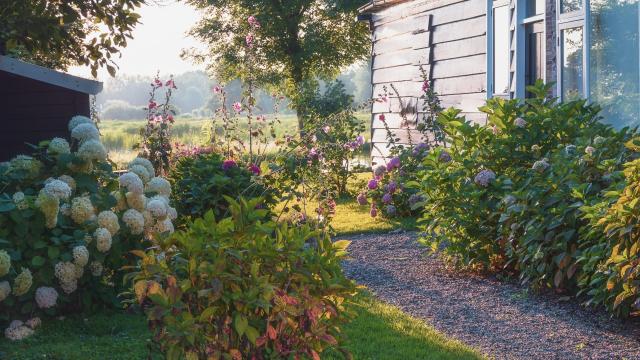Deciding where to plant your garden depends a lot on sun exposure — where the sun hits your yard, and for how long. But shade can be more helpful than you might think, protecting your plants from the summer heat and preventing them from sunburn or getting too dried out. Some plants even love the shade more than the sun.
If you choose the right plants, your garden can reach outdoor spaces that typically don’t get much sun. Here are some tips for planting a garden that thrives in the shade.
What is a shade garden?
A shade garden has plants that need little to no sunlight to grow. If your yard has a lot of trees with a canopy that lets little light through, or if your house or porch blocks light from hitting your back yard for long stretches of time, a shade garden is probably right for you.
What counts as “little to no light”? According to the Gardenista, shade gardens refer to plants that can live with less than four hours of sunlight per day.
There are three types of shade
Plants need some sort of sun, but whether it’s indirect or short-lived is what matters. Shade is broken up into different categories: partial shade, dense shade, and full shade. According to Pennington, partial or “medium shade” refers to half a day of shade, about six hours; full shade may sound like complete darkness, but actually equals about two hours of direct sun; and dense shade means only indirect sunlight for a short period during the day.
Other degrees like “light shade,” “dappled shade,” or “filtered shade” are described as “areas along the edges of shady gardens or where sunlight filters through leaves and hits the ground all day.” Before picking out any plants, access the shade levels in your yard, because that’ll determine the types of plants you want to buy.
How to plan your shade garden plot
Before you buy any plants, you’ll need to know what type of garden you want and where you want to plant. Real Simple spoke with Gardener and lifestyle writer Stacie Abdallah who suggests knowing your zone and planting native plants to withstand the climate and maintain the natural ecosystem. Abdallah also recommends sketching out where to plant your shade garden before even picking up the seeds.
For example, decide whether you want raised plant beds or if you’ll be growing in the ground close to your house, and how much square footage you have to play with. And if you’re planting around trees, you’ll want to plant far enough to avoid damaging the trees roots or having the tree’s roots stealing water from your shade plants.
Choosing the right plants for your shade garden
Consider the type of space you want to create. If you want a retreat where you can sit in the shade and enjoy the landscape, you might want to plant flowering shrubs like rhododendrons that require partial shade and look beautiful next to a porch or garden bench. Or there’s clethra, which produces light pink flowers. For lush greenery, there are hosta plants that work well with stone pathways.
If you want a vegetable garden that can survive your shady yard, Real Simple suggests low-light vegetables like spinach, chard, and kale, which will also survive through the fall. If you’d rather cover more ground or replace your grass with something that will survive your low-light lawn (besides low-light grass), you might choose sprawling plants like purple coleus or, for a focal point, black mondo grass.
Things to look out for when caring for a shade garden
The best part of a shade garden is that less light tends to mean fewer weeds, but there are other issues you’ll need to manage instead. Aside from avoiding hurting the trees when digging your garden, it’s worth mentioning again that you’ll want to plant far enough away from tree roots that can steal water from your shade plants. You’ll also need to watch out for fungi and fungal plant diseases. Since shade gardens don’t get much sun, they also don’t dry out as easily as sun-exposed plants after a watering or heavy rain, so you’ll need to monitor them closely and treat any signs of disease if they arise.

Leave a Reply
You must be logged in to post a comment.